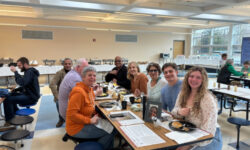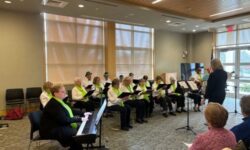by Audrey Anderson
Hometown Weekly Reporter
On November 8, the Westwood Historical Society's program Pilgrims and the First Thanksgiving was held at the Fisher School. Presenter John Horrigan gave a detailed and lively talk on the hard journey of the Mayflower passengers and their difficult early years in Plymouth. Horrigan, a popular historian, is known for his NEWTV (Newton Media Center) show "The Folklorist," for which he has won five Emmy awards for the Boston/New England area.
The Fisher School is Westwood's 1845 Greek Revival one-room schoolhouse. The school was a fitting place for an historical presentation. Some original woodwork remains, and the original wallpaper was reproduced and now adorns the walls. Sitting in this 178-year-old school building, the audience felt the weight of those who came before, even before the presentation started.
Horrigan started his story with the bold decision of the passengers to leave England. They had to get permission from English government officials to sail to Leiden in the Netherlands, on the first leg of their journey to North America. While in Leiden, they put away provisions for the trans-Atlantic journey and looked for captains who would take them. They wanted to leave in early spring, but preparations took longer than they hoped, and their ships, the Speedwell and the Mayflower, did not raise their anchors until September 15.
Not long into their journey, the Speedwell started leaking. The two vessels turned back and everyone moved to the Mayflower, leaving the Speedwell in the dock. One hundred and ten passengers, including 50 men, 19 women, and 41 children and young adults set sail for the new world. Not all were traveling for religious freedom, as the group called the "pilgrims" were. Others, known as "travelers, strangers, or sojourners," were going to the new world for other reasons.
The beginning of the journey was calm, but then the Mayflower was wracked by high waves and winds. In a heavy storm, the main beam of the ship cracked. Amazingly, the passengers were able to repair it with a jackscrew they brought with them for the purpose of building houses. The travelers were wet and cold, and they started to get sick.
The Mayflower first landed in November in Provincetown. The plan was to land in Virginia, but the ship had been blown off course by the high winds. They encountered a difficult area to sail at the bottom of Cape Cod's arm, so they turned around and dropped anchor at the top of the arm. The men went out to explore the area, while the women stayed in the wet, cold ship throughout the first winter. Eventually they sailed down to Plymouth and decided to call it home.
When spring came, a native named Samoset helped the passengers to fish, plant crops, and hunt, and they built their houses at Plymouth. By the fall, only 57 of the original Mayflower passengers had survived. They invited 90 natives to a feast or series of feasts to thank God for their first year in the new world. Four women had survived to this point, and, according to a document written at the time, they were in charge of cooking the food for the feast. The group likely ate blueberries, cranberries, corn, pumpkin, venison, and turkeys.
If you would like to learn more, Horrigan recommended the following books about the journey on the Mayflower and the settlement in Plymouth:
“Strangers and Pilgrims, Travellers and Sojourners: Leiden and the Foundations of Plymouth Plantation” by Jeremy Dupertuis Bangs
“Of Plymouth Plantation” by William Bradford
“Mayflower” by Nathaniel Philbrick
“Mourt's Relation: A Journal of the Pilgrims at Plymouth” by Anonymous


























